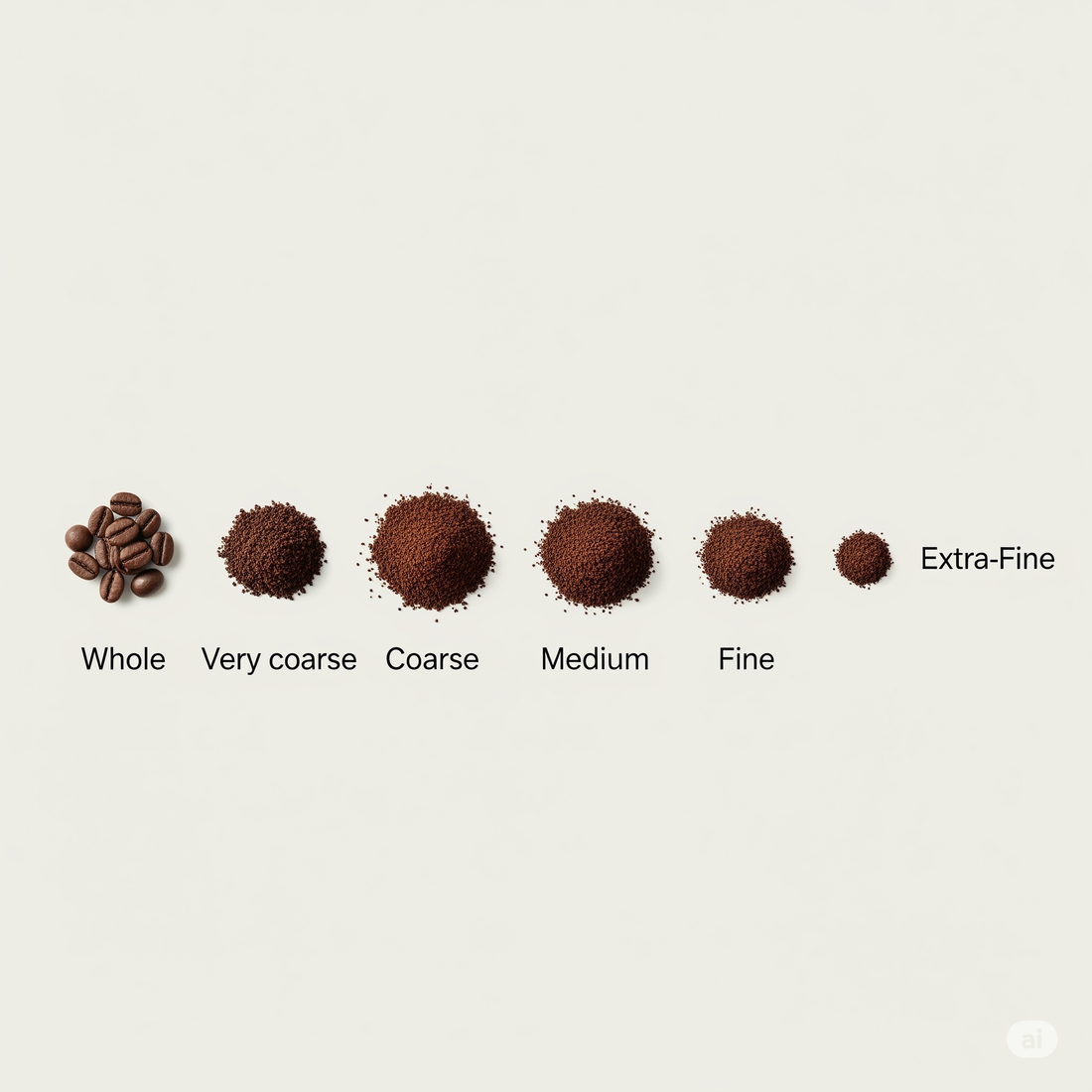Published by coffeemove.eu on June 26, 2025
Author: Jonas Folschette
Welcome to the fascinating world of coffee! You may have already acquired the best beans and a fantastic coffee maker from our shop. But there's one variable that's often overlooked, yet has the greatest influence on the final taste in your cup: the grind.
But don't worry! With this guide, we'll guide you through the grind jungle and show you how to find the perfect setting for every grinder and brewing method.
Table of contents
- Why is the grind so important?
- The grind size for your preparation method
- Your hand mill in detail: How to find the perfect setting
- Electric grinders: Convenience meets consistency
- The impact knife mill: better than its reputation?
- Troubleshooting: Your coffee doesn’t taste good?
Why is the grind so important?
The science of extraction
Imagine coffee grounds as a collection of tiny particles. When water flows over them, they release the flavors. This process is called extraction . The grind size is the most important factor in determining the contact time between the water and the coffee.
Grind too coarse: The water rushes through the large gaps too quickly. It doesn't have enough time to release the aromas. Your coffee tastes sour, thin, watery, and sometimes even green or unripe. (Under-extraction)
Grind too fine: The water builds up and struggles through the dense coffee grounds. It releases too many bitter compounds. Your coffee tastes bitter, empty, and often astringent (a dry, fuzzy mouthfeel). (Over-extraction)
The Perfect grind: The water flows through at the ideal speed, releasing just the right amount of sweet, fruity, and complex flavors. Your coffee is balanced, sweet, and full-bodied. (Ideal extraction)
The golden rule is: the shorter the planned contact time between water and coffee, the finer the grind must be.
Side note: Keep in mind that in addition to the grind size, the coffee quantity (dose), water temperature, and water quality also influence the extraction. Think of them as a team, with the grind size as the captain.
The grind size for your preparation method
Here are our recommendations for all brewing methods that you can find in our shop:
Coarse (consistency like coarse sea salt, ≈1000 µm):
- French Press (press pot):
Here, the coffee steeps in the water for a long time (approximately 4 minutes). A coarse grind is crucial to prevent the coffee from becoming bitter and the metal filter from clogging. - Espro Press:
Thanks to its patented double microfilter, you can grind a little finer than with a classic French press (more medium-coarse) to achieve an even fuller extraction without having coffee grounds in your cup. - Cold Brew (Full Immersion):
With the classic method (12-24 hours brewing time), a very coarse grind is mandatory to avoid bitter over-extraction.
Medium (consistency like sand, from fine to normal):
- Filter coffee machine:
A medium grind is the standard for a balanced cup. - Pour over (Hario V60, Graycano):
Precision is required here. Start with a medium-fine grind. A common guideline for the brewing ratio (coffee to water) is 1:16 (e.g., 15g of coffee to 240g of water). Aim for a brewing time of 2:30 to 3:30 minutes. - Coffee brewer from The Brew Company:
Since this works like a pour-over bag, a medium-fine grind is ideal here too.
Fine (consistency like table salt to powdered sugar):
- Espresso maker / moka pot (Bialetti):
Requires a fine grind, but not quite as fine as for a portafilter machine. The consistency of table salt is a good guideline. Fill the sieve loosely and do not tamp the powder, as this could create too much pressure and trigger the safety valve. - AeroPress:
The wonder child! For the classic method, a medium-fine grind is ideal. For the inverted method, where the coffee brews longer, you can grind a little coarser. For quick, espresso-like shots, go for the finer range. - Hand-held espresso machines:
Here you need a very fine, powdered sugar-like and, above all, very even grind in order to be able to build up the necessary pressure.
Special case: Slow Drip Cold Brew (Hario Water Dripper)
With this method, the water drips very slowly. A medium-fine to medium grind is optimal to allow the water to absorb the flavors without clogging.
Your hand mill in detail: How to find the perfect setting
Every hand mill is a small mechanical masterpiece. Find your zero point by carefully tightening the adjustment ring and count back the clicks from there. Use our values as a starting point and adjust to your liking!
Comandante C40: The scale of the scene
The Comandante from Germany is the gold standard among hand grinders, famous for its "Nitro Blade" grinding mechanism.
Starting points (standard axis):
- French Press: 35-40 clicks
- Pour-Over (V60): 22-28 clicks
- AeroPress: 18-22 clicks
- Moka pot: 15-18 clicks
Timemore (e.g. Chestnut C2/C3): The price-performance champion
Timemore offers outstanding grinding quality at an incredibly fair price.
Starting points (from zero point):
- French Press: 23-26 clicks
- Pour-Over (V60): 15-20 clicks
- AeroPress: 12-15 clicks
- Moka pot: 9-12 clicks
1Zpresso (e.g. K-Series : K-Max/K-Ultra ± 0.2 scale points): The master of micro-adjustment
1Zpresso grinders are known for their extremely fine adjustment via an external ring, indicated in numbers and revolutions.
Starting points (example K-Max/K-Ultra):
- French Press: 7.0 - 8.0 on the scale
- Pour-Over (V60): 5.5 - 6.5 on the scale
- Note: The scales of the J, K, Q, and X series vary considerably. Please always refer to your manual!
Kinu (e.g. M47 series): German engineering
Kinu mills stand for solid construction and a stepless or micrometric grinding adjustment.
Starting points (example M47 Phoenix):
- Pour-Over (V60): 3.8 - 4.2 on the scale
- AeroPress: 3.0 - 3.5 on the scale
- Moka pot: 1.5 - 2.5 on the scale
Hario (Mini-Slim, Skerton): The perfect introduction
Robust, reliable and perfect for learning the basic interplay of grind size and taste.
Starting points (from zero point):
- French Press: 14-16 clicks
- Pour-Over / Filter: 10-12 clicks
- AeroPress: 7-9 clicks
Etzner (etz-I): The technological revolution
A masterpiece of engineering, the outer grinding ring rotates while the inner cone remains fixed. This results in an extremely consistent grind with fewer fine particles and an incredibly clear flavor. Refer to the easy-to-read scale and the manufacturer's recommendations for guidance.
Electric mills with grinder (e.g. Melitta Molino)
Electric grinders offer convenience and consistency at the touch of a button. The Melitta Molino, for example, uses a professional disc grinder and a numbered scale from 1 (fine) to 17 (coarse).
Starting points:
- French Press: 14-17.
Note: Above level 12, the uniformity may decrease somewhat. - Filter coffee/pour-over: 7-12
- Moka pot: 2-4
The biggest advantage is often the automatic quantity control: you set the number of cups you need, the grinder grinds exactly the right amount and switches itself off.
The impact knife mill: better than its reputation?
Let's face it: A blade grinder can never achieve the consistency of a grinder with a burr grinder. It smashes the beans instead of grinding them , resulting in a mixture of dust and large lumps. This almost inevitably leads to an uneven extraction (the finer parts become bitter, the coarser parts acidic).
Still, it's better than no grinder at all! Freshly ground coffee is still more aromatic than coffee that's been pre-ground for weeks.
How to get the most out of your impact knife mill:
- Pulse, do not grind continuously!
This is the most important trick. Press the button for only 2-3 seconds, stop, and repeat. - Shake!
Between pulses, shake the grinder vigorously. This will cause the large pieces to fall back down to the blades and be further ground. - Hearing and seeing:
Over time, you will develop a feel for the sound and be able to roughly estimate the consistency through the lid. - Time as a guideline:
- Coarse (French Press): 2-3 short pulses (approx. 5-7 seconds total)
- Medium (filter): 4-5 pulses (approx. 10-12 seconds total)
- Fine (Moka pot): 6-8 pulses (approx. 15+ seconds total)
Bottom line: A grinder is fine for beginners. But once you realize how much you love fresh coffee, the next logical step in your coffee journey will be a grinder with a real grinder. You'll taste the difference.
Troubleshooting: Your coffee doesn’t taste good?
|
When your coffee tastes like this... |
...he is probably... |
Your next action is... |
|
Sour, thin, watery, empty |
Under-extracted |
Grind finer (fewer clicks / smaller number) |
|
Bitter, dry, furry |
Over-extracted |
Grind coarser (more clicks / larger number) |
We hope this guide helps you on your journey to the perfect coffee. Remember: every bean is different. Experiment, taste, and above all: enjoy the process!
If you have any further questions, don't hesitate to contact us. We'll be happy to help!

